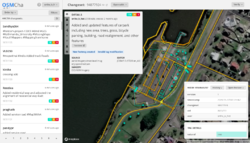OSMCha
| OSMCha | |
|---|---|
| Author: | Wille Marcel and others (mapbox/osmcha-frontend/graphs/contributors GitHub) |
| License: | ISC License |
| Platform: | Web |
| Status: | Active |
| Version: | 1.1.0 releases (2024-11-07) |
| Website: | osmcha.org |
| Source code: | OSMCha/osmcha-frontend GitHub, OSMCha/osmcha-django GitHub |
|
OSM Changeset review tool | |
OSMCha short for OpenStreetMap Changeset Analyzer is a web tool to help mappers analyze and review data changes to OSM. The objective of the tool is to help detect vandalism and act on bad changes to the map data.
History
OSMCha was originally written by Wille Marcel in 2015 to investigate suspicious changesets on OSM. A global instance was later hosted by Mapbox as an additional data QA tool for the OSM community.[1] In 2023, it became a charter project of OpenStreetMap U.S.[2]
Features
Changeset Explorer
OSMCha is an advanced changeset explorer. Changesets on OpenStreetMap have timestamp, editor used, changeset comment, bounding box of the changeset, username of the author and other metadata . OSMCha stores these changeset metadata and allows searching through them.
Filters
The user interface of OSMCha allows multiple user input of metadata values for searching through the changeset database. This includes various characteristics of the changeset and also auto-detection of suspicious edits.
These values can be saved to be used later. You can make an RSS feed from a saved filter, by following Mannivu's guide. The RSS will be updated when new activity matches the filter.
Known issues
There are issues with user interface in displaying area of interest filters (polygon/bounding box) which hinder new users, while the filters work well once set.[3] [4] [5]
Due to cost reduction OSMCha only allows seeing changesets from Jan 1st, 2023.[6]
Using OSMCha
- Changeset review requested by new mappers or anyone
- Changesets automatically flagged for review
- New mappers adding a new city/country, mass deletion , invalid tag change or flagged for review
- New mappers deleting features using JOSM or any mature feature
- Large data additions or imports by new mappers or anyone
- Changesets with "revert" in comment or using the reverter plugin
- Changesets for #missingmaps or #hotosm
Using OSMCha API
OSMCha review data is available through API. A website is also available for interactively exploring API.[7] Please follow the instructions below.
- Try Social-auth API post call with empty data in oauthheader values. You will recieve oauth_token, oauth_token_secret as response.
- Use the url https://www.openstreetmap.org/oauth/authorize?oauth_token=<oauth_token received in the previous step> in the browser to login to OSM and provide permissions
- The browser url redirects to https://osmcha.org/oauth-landing.html?oauth_token=<oauth_token>&oauth_verifier=<oauth_verifier>
- Try Social-auth API post call again by filling in oauthheader with all the values received so far, including oauth_verifier received in the earlier step. Now you will receive a response called "token": <value>
- Use token value prefixed with "Token " (note the space character after the word Token) as your OSMCha API access token and authorize by clicking on the Authorize button. Store the token in a confidential storage area, so that you can start with step 5 for additonal sessions after you close the present session.
- Now you can try out any API on the page, by filling necessary inputs.
Useful browser extensions
JumpToOSMChangesetAnalyzer
Jump to OSM Changeset Analyzer is a browser extension to switch to OSMCha and other tools.[8]
OSM Smart Menu
OSM Smart Menu is a browser extension to open OSMCha and several other OSM utilities when browsing OpenStreetMap.org.
See also
- OsmCha's Usage guide
- Guide Finding suspicious map edits using OSMCha by Mapbox- A walkthrough of how to detect, inspect and fix potentially harmful changes in OpenStreetMap using OSMCha.
External links
- OSMCha
- OSMCha for OpenHistoricalMap
- Wille's presentation to OSM board on 2021-11-26 which includes an architecture slide
- OSMCha: A Decade of Validating OpenStreetMap - Development Seed Blog (Wille Marcel, June 3, 2024)
- The State of OSMCha – Wille Marcel – State of the Map US 2023 [YouTube]
- OpenStreetMap US Mappy Hour: OSMCha - March 2023 [YouTube]
References
- ↑ Anwar, Sajjad (January 29, 2017). “Validating and protecting OpenStreetMap”. maps for developers. Mapbox. Retrieved February 17, 2023.
- ↑ “Welcoming OSMCha as an OSM US Charter Project”. OpenStreetMap U.S. February 17, 2023. Retrieved February 17, 2023.
- ↑ Bbox field shows only the first coordinate
- ↑ filter polygon doesn't appear on map initially #474
- ↑ OSMCha frontend issue list
- ↑ openstreetmap.us: OSMCha has a new home at OpenStreetMap US
- ↑ OSMCha API docs with interacivity
- ↑ JumpToOSMChangesetAnalyzer browser extension
